Discovering Small Trees Perfect for Shady Spaces
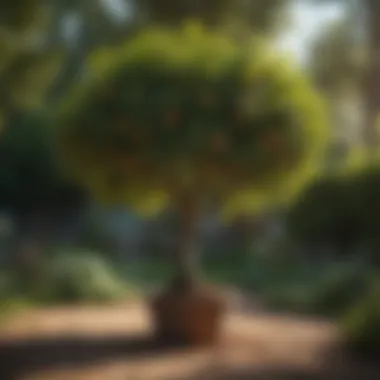

Intro
In urban and suburban landscapes, spaces with limited sunlight often pose challenges for homeowners and gardeners. However, there is a solution: small trees that thrive in shady environments. These trees not only adapt well to lower light conditions, but they also offer unique characteristics and benefits that can enhance any landscape.
This article aims to explore the various species of small trees perfect for shaded areas. It will discuss their ecological advantages, care requirements, and their role in aesthetic improvement. Understanding these aspects can help gardening enthusiasts select the ideal species for their needs and make informed choices in landscaping.
The journey into the realm of small shaded trees will cover key points such as design inspirations, maintenance needs, and the environmental benefits these trees provide. Recognizing the diverse options available allows for creativity in garden design, leading to beautiful, functional outdoor spaces.
Design Inspirations
Small trees can redefine shaded corners, bringing life and style. Utilizing these trees, homeowners can create inviting, layered landscapes.
Trending Styles
When considering small trees for shade, various styles emerge as popular choices:
- Cottage Gardens: Incorporating trees like the Amelanchier arborea adds charm. This can create a soft, relaxed atmosphere.
- Modern Minimalist: Species such as Cornus kousa bring a striking look. They work well with clean lines and open spaces.
- Woodland Gardens: Trees like Acer palmatum fit perfectly. Their multi-season interest complements the natural landscape.
These styles highlight the versatility small trees offer, adapting to any taste.
Color Palettes
Color plays a crucial role in design. Choosing trees that offer varied foliage can dramatically impact the overall appearance. Consider:
- Green Varieties: Shades of green provide fresh backdrops. Trees like Ilex crenata create a lush effect.
- Autumn Hues: Trees such as Liquidambar styraciflua showcase vibrant fall colors, enhancing seasonal beauty.
- Blossom Colors: The Prunus serrulata, known for its pink blooms, adds delightful spring interest.
These color choices can build harmony in design, inviting visual engagement without overwhelming the space.
Maintenance and Upkeep
Caring for small trees in shade involves understanding their needs. This section outlines essential maintenance tasks.
Seasonal Maintenance Checklist
To maintain the health and beauty of small trees, consider the following tasks throughout the year:
- Spring: Fertilize and prune to encourage growth.
- Summer: Monitor for pests and ensure proper watering.
- Fall: Clean fallen leaves to prevent diseases.
- Winter: Inspect for damage and protect roots from frost.
Effective maintenance ensures longevity and vibrancy of your trees.
Cleaning and Organization Tips
Keeping shaded areas tidy is crucial. Incorporate these cleaning strategies:
- Regularly clear debris around the base of the tree.
- Use mulch to suppress weeds and retain moisture.
- Organize planting beds with a consistent layout for clarity.
Good organization not only maintains health but also enhances aesthetic appeal.
Small trees in shaded areas offer tremendous potential for creating engaging landscapes, elevating both ecological function and visual interest.
Understanding Shade Tolerance
Shade tolerance refers to a tree's ability to grow and develop in low light conditions. It is a crucial aspect, especially when considering landscapes that do not receive ample sunlight. Many gardeners and homeowners may focus solely on sun-loving plants, but understanding shade tolerance opens up possibilities for enhancing green spaces that otherwise seem challenging.
In the context of small trees, shade tolerance plays a significant role in determining species selection for various landscaping objectives. By recognizing which trees can thrive in such environments, it becomes easier to plan and execute a shade-dominated landscape that is both attractive and functional. Additionally, integrating shade-tolerant trees can create microhabitats that benefit various wildlife and enhance the ecological balance in urban and suburban settings.
Definition of Shade Tolerance
Shade tolerance is generally classified into three categories:
- Shade Tolerant: These trees can thrive in low light conditions. They often have a slower growth rate and can survive under thicker canopies. Examples include the Eastern Redbud and certain varieties of Dogwoods.
- Intermediate Shade Tolerant: These trees require partial shade but can adapt to slightly brighter conditions. They are not as resilient as shade-tolerant species but can still perform adequately in moderate light.
- Shade Intolerant: These trees need full sun and do not fare well in shaded environments. This classification helps to understand which tree species to avoid placing in shaded areas since they will struggle to survive.
Understanding the specific shade profile of a planting site is essential. Factors such as the density of tree cover, surrounding structures, and geographic location can influence the amount of light available.
Importance in Landscaping
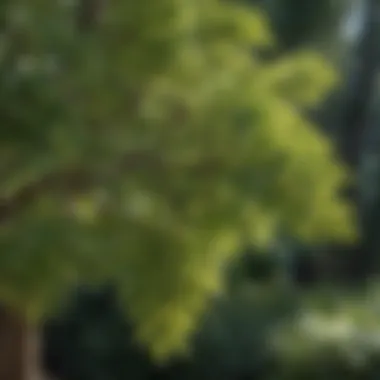
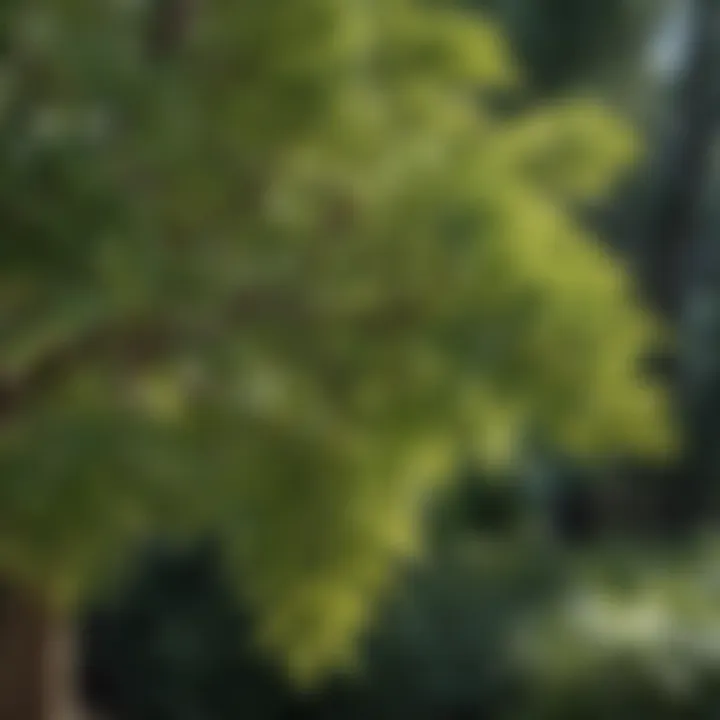
Recognizing shade tolerance is important for various reasons:
- Diversity: Incorporating shade-tolerant small trees introduces biodiversity into a landscape. Different species create a more complex ecosystem that can lower pest populations and enhance soil health.
- Aesthetic Appeal: Proper selection of trees that thrive in shade can improve the aesthetic quality of a landscape. They can provide structure, color, and texture that complement other plants.
- Environmental Stability: Trees that are suited for shaded areas contribute to soil development and erosion control. Their root systems promote soil stability while improved foliage enhances carbon sequestration.
- Microclimate Creation: Shade trees can help to moderate temperatures in surrounding areas, making spaces more comfortable during hotter months. They create a cooler microclimate that supports diverse plant life.
- Functional Uses: Shade-tolerant trees can provide screening, privacy, and windbreaks. Their strategic placement can lead to more energy-efficient home designs by reducing heat gain.
Understanding shade tolerance combined with the selection of appropriate small trees reinforces a landscape’s overall health and beauty. The right choices not only elevate the aesthetic value but also contribute positively to the local environment.
"Choosing the right trees for shaded locations can transform dull spaces into vibrant, life-filled environments."
As this article unfolds, we will explore not just the characteristics of small trees that thrive in shade but also how best to integrate them into landscape designs that enhance both beauty and function.
Characteristics of Small Trees for Shade
Understanding the characteristics of small trees suited for shady environments is crucial for any gardening enthusiast or homeowner seeking to enhance their landscape. These trees not only provide aesthetic value but also contribute to ecological sustainability. Identifying the right species and understanding their unique traits leads to successful planting and maintenance of these trees.
Growth Habits
Growth habits describe how a tree develops in terms of size, shape, and root structure. Small trees that thrive in shade often exhibit compact growth patterns, which can be beneficial in limited spaces. These trees usually reach heights of less than 30 feet, making them ideal for residential gardens.
Many shade-tolerant species grow slowly and maintain a dense canopy, offering more shade as they mature. This can greatly influence how you plan your garden or yard. When selecting small trees, consider the average growth rate and final size, as these will affect placement.
Leaf Structure and Color
The leaf structure and color of shade-tolerant trees vary widely. Generally, these trees have larger leaves compared to those growing in full sun. This adaptation allows them to capture more sunlight in shaded environments. The shape and arrangement of leaves also play a role in the tree’s overall health. For example, trees with broad, flat leaves may channel more light for photosynthesis, enhancing their growth in less optimal conditions.
Color can range from vibrant greens to variegated patterns, which can create visual interest even in low light. Some species even display seasonal changes in leaf color, adding to the landscape’s overall dynamism. Note that leaf color can be an indicator of the tree's health and the quality of the growing environment.
Flowering and Fruiting Patterns
Small trees that thrive in shade often have unique flowering and fruiting patterns. Many of these species bloom in spring or early summer, producing beautiful flowers that attract beneficial insects, such as bees and butterflies. The timing of the flowering period may vary based on the specific tree and its location.
Fruiting can also be significant in these trees. Some species may produce edible fruits, which can be a delightful addition to gardens and landscapes. These fruiting patterns contribute to biodiversity and provide food for wildlife. Additionally, in planning a garden, consider how these patterns can enhance year-round interest in your landscape.
Understanding the characteristics of small shade trees helps in making informed choices. Proper selection enhances not just beauty but ecological health as well.
In summary, understanding the growth habits, leaf structure, and flowering patterns of small trees for shaded areas will guide you in selecting and maintaining the right species for your landscape. Taking into account these characteristics is essential for achieving a thriving garden that resonates with both aesthetic and ecological values.
Popular Small Trees for Shady Areas
The inclusion of small trees in shaded environments is vital for creating lush, diverse landscapes. These trees not only fill the space aesthetically but also provide numerous ecological benefits. When choosing small trees for shady areas, one must consider factors such as the tree's growth habits, moisture needs, and companion planting possibilities. Understanding which species thrive in lower light conditions can enhance the overall health of your garden while offering unique visual textures and colors throughout the year.
Japanese Maple (Acer palmatum)
Japanese Maple is a quintessential choice for shaded areas, praised for its stunning foliage and graceful branching structure. These trees come in various cultivars, displaying a spectrum of leaf colors, including deep reds, greens, and even purples. They often reach a height of about 10 to 25 feet, making them ideal for smaller yards.
The Japanese Maple prefers well-drained soil and benefits from a protected spot away from harsh winds. In partial shade, these trees tend to have more vibrant colors, particularly in spring and fall, adding depth to the landscape.
Redbud (Cercis canadensis)
Redbud trees are well-suited to shaded environments, showcasing heart-shaped leaves and vibrant pink flowers in early spring. Their architectural shape adds both beauty and structure to any garden setting. Redbuds typically reach a height of 20 to 30 feet and can adapt to various soil conditions, though they favor moist, well-draining substrates.
Planting these trees in partial to full shade can produce richer foliage and better flowering. The early blooms attract pollinators, enriching the local ecosystem while giving your landscape a burst of color when it is most needed.
Serviceberry (Amelanchier spp.)
Serviceberry trees are an excellent choice for shaded areas, combining ornamental beauty with ecological benefits. These trees exhibit delicate white flowers in spring, edible berries in summer, and stunning fall foliage. They generally reach heights between 15 to 30 feet, making them suitable for limited spaces.
Serviceberries thrive in adaptable soil types and prefer moist conditions. Their shallow root systems and smaller profile allow them to fit comfortably beneath taller trees, providing a multi-layered look in shaded gardens. The berries are tasty and attract birds, enriching your garden's biodiversity.
Dogwood (Cornus spp.)
Dogwood trees, particularly the flowering variety, offer exceptional beauty in shaded areas. They provide an impressive display of blooms in spring and attractive foliage that can turn a vibrant red in fall. These trees typically grow to about 15 to 30 feet, with some varieties suitable for small gardens.
Dogwoods thrive in rich, well-drained soil and can tolerate shade, making them suitable for planting under taller trees. Their unique structure and seasonal changes contribute significantly to the landscape’s visual appeal and enhance biodiversity in the garden.
Hawthorn (Crataegus spp.)
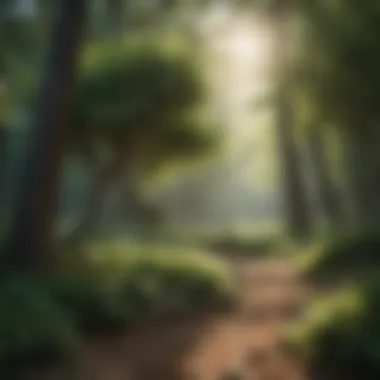

Hawthorn trees are resilient and adaptable, thriving in various conditions including partial shade. They feature attractive flower clusters in spring, followed by small, red berries in fall that are favored by many birds. Generally growing around 15 to 30 feet tall, they fit well in smaller spaces.
These trees tolerate a range of soil types, though they prefer well-drained conditions. Planting hawthorn in the shade will lead to slower growth but can enhance the tree's unique form and overall hardiness.
Not only do small shade trees like these enhance the beauty of a garden, but they also contribute to environmental health by providing habitat and food for wildlife.
Selecting the right small trees for shade brings both functional and aesthetic value to gardening spaces. Their diverse characteristics allow homeowners to create a rich tapestry of colors and textures, while their contributions to environmental health cannot be overlooked. Regular consideration of their specific needs will improve success in maintaining these beautiful features in the landscape.
Evaluating Environmental Conditions
Understanding the environmental conditions is crucial in selecting small trees that thrive in shaded areas. Each element can greatly influence tree growth and health. Evaluating soil quality, moisture levels, and available growth space aids in determining the best trees for your landscape. Proper consideration of these factors leads to a successful gardening experience and enhances the ecological balance in your garden.
Soil Quality and Composition
Soil is the foundation for any tree. Assessing soil quality involves understanding its structure, pH level, and nutrient content. Soil that is too compact can restrict root growth, while overly sandy soils can cause drainage issues. A balanced loamy soil often yields the best results. It should have a mix of sand, silt, and clay. Testing the soil can reveal its composition and help you amend it if necessary. Common amendments include compost and peat moss to improve fertility.
Moisture Levels
Moisture directly affects tree health. In shaded areas, the amount of rainfall that reaches the ground can be less due to the canopy made by larger surrounding trees. It’s essential to maintain optimal moisture, which often requires regular monitoring. Too much moisture can lead to root rot, while too little can stunt growth. Mulching around the base of trees can help retain moisture, reduce weed competition, and stabilize soil temperatures, benefiting tree development.
Growth Space Considerations
Adequate growth space around the trees is also necessary. Small trees still need room for their roots and canopies to expand. Crowding can lead to competition for sunlight, nutrients, and water. Understanding the mature size of the tree species chosen is important. Planting too close may inhibit growth and invite disease. It's wise to research spacing recommendations based on specific species. Also, consider the proximity to other plants or structures, as this can impact airflow and sunlight exposure.
"Evaluating environmental conditions not only enhances the beauty of your garden but also supports the robust health of your plants."
By thoroughly assessing soil quality, moisture, and space, you can create an optimal environment for small trees in your shaded landscaping. Doing so will foster a flourishing green space that enriches the landscape and contributes to local ecology.
Planting and Maintenance
The planting and maintenance of small shade trees are crucial to ensuring their successful growth and longevity. These trees exhibit unique requirements, particularly in shaded environments, that demand attention from the gardener. Understanding the specific elements involved in this process can lead to healthier trees and a thriving landscape.
Site Selection and Preparation
Choosing the right location for your small shade trees is paramount. This step involves assessing light availability, soil conditions, and surrounding plants. The tree should be planted where it receives the right amount of filtered sunlight. This may mean placing it near taller trees that provide dappled light rather than full shade.
Preparation of the site includes clearing any debris and checking for compacted soil. Often, you may need to amend the soil with organic matter to improve drainage and nutrient content. When preparing the planting hole, it should be twice as wide and just as deep as the root ball of the tree to encourage root expansion.
Watering and Fertilization Needs
Watering needs vary greatly depending on the tree species and existing moisture levels in the soil. Newly planted trees may require consistent watering to establish their roots. Deep watering encourages deeper root growth, which is essential for stability and drought resistance. It's advisable to monitor the soil moisture and water deeply, yet infrequently, to prevent waterlogging.
Fertilization plays a role in the overall health of the tree. A slow-release fertilizer can be beneficial when applied in spring. However, care must be taken as over-fertilization can be harmful. A soil test can help you determine the right amount of nutrients that your tree needs to thrive in its shaded environment.
Pruning Techniques
Pruning is a necessary practice that helps maintain the structure and health of small shade trees. Proper pruning encourages development of strong branches and reduces the risk of disease. It is best to prune during the tree's dormant season, which is usually late winter or early spring.
Begin by removing any dead, diseased, or damaged branches. Focus on creating an open structure that allows light to penetrate and air to circulate within the canopy. This will help reduce the risk of fungal infections. Avoid cutting too much at once; a good rule of thumb is to remove no more than 25% of the tree's foliage in one season.
Proper pruning enhances both the aesthetics and health of small shade trees.
Ecological Benefits of Small Shade Trees
Small shade trees are not only aesthetically pleasing but also contribute significantly to the environment. The presence of these trees in urban and suburban landscapes can enhance ecological balance. As we explore the ecological benefits of small shade trees, we will focus on three primary aspects: improvement of air quality, support for biodiversity, and control of soil erosion.
Improvement of Air Quality
Small shade trees play a crucial role in improving air quality. They absorb carbon dioxide during photosynthesis and release oxygen back into the atmosphere. This natural process is essential for maintaining breathable air, especially in urban areas where pollution levels are often higher. In addition, these trees trap particulate matter such as dust and smoke, effectively reducing the levels of airborne toxins.
The leaves of these trees capture pollutants on their surface, which can then be washed away by rain. This ability to filter pollutants highlights their importance in mitigating the effects of urbanization. Trees like the Eastern Redbud (Cercis canadensis) not only beautify spaces but also act as natural air purifiers.
Biodiversity Support
The presence of small shade trees fosters rich biodiversity in landscapes. Birds, insects, and other wildlife find shelter, food, and nesting opportunities in these trees. For instance, the Serviceberry (Amelanchier spp.) produces fruits that attract various bird species, while its flowers provide nectar for pollinators such as bees.
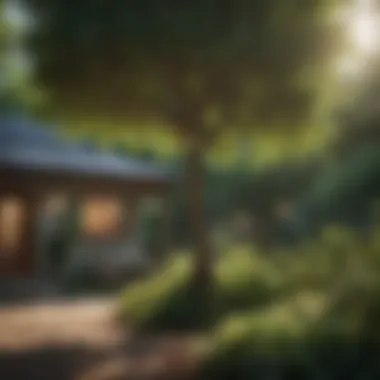
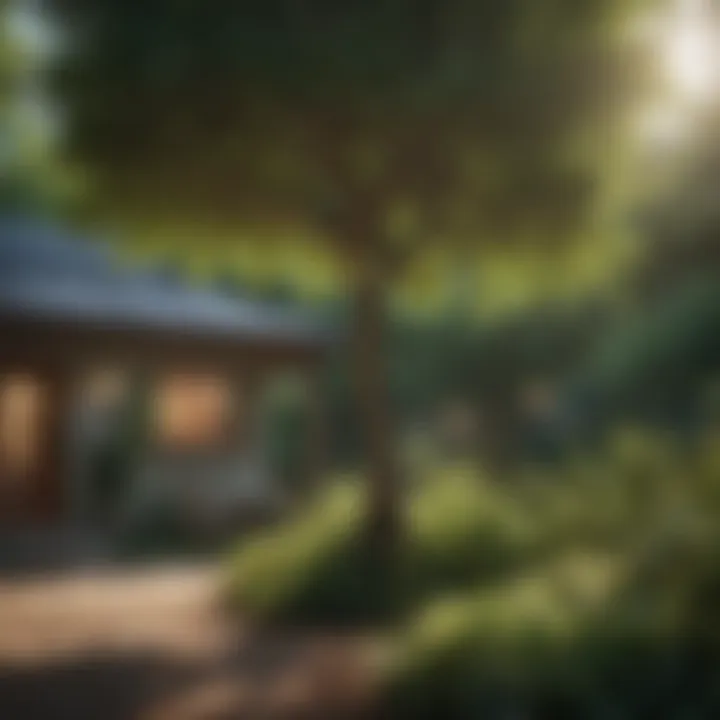
Moreover, the undergrowth beneath these trees often supports diverse plant species, creating a habitat rich in variety. This ecological dynamic is vital for maintaining healthy ecosystems. Homeowners can contribute to this biodiversity by carefully selecting tree species that support local wildlife.
Soil Erosion Control
The root systems of small shade trees help bind the soil together, reducing the risk of erosion. This is particularly beneficial in areas prone to heavy rainfall or in sloped landscapes. By stabilizing the soil, these trees prevent runoff and promote water infiltration, which is crucial for maintaining healthy groundwater levels.
Additionally, the canopy of shade trees reduces the impact of raindrops on the soil, further minimizing erosion. Trees like the Dogwood (Cornus spp.) are excellent at erosion control due to their extensive root systems. Planting these trees strategically across properties can significantly enhance soil stability and contribute to overall landscape health.
"Small trees enrich the environment and offer significant ecological advantages, supporting air quality, biodiversity, and soil health."
Designing With Small Trees in Mind
Incorporating small trees into landscaping with careful considerations can greatly enhance the overall aesthetic and functionality of shaded areas. Using these trees thoughtfully not only adds beauty but also supports biodiversity, aids in air quality improvement, and contributes to the ecological balance of a space. When designing with small trees, several elements come into play, such as their placement, compatibility with existing features, and the visual dynamics they create in the landscape. Such considerations ultimately contribute to a well-rounded outdoor environment that is pleasing and functional.
Creating Visual Interest
Visual appeal is paramount when designing any landscape. Small trees offer various forms, colors, and textures which can bring remarkable contrast to shaded areas. For instance, the delicate leaves of a Japanese Maple can provide a stunning visual in spring, while the vibrant fall colors add drama to an otherwise subdued area. To create visual interest, consider these aspects:
- Layering Plant Heights: Position smaller trees in front of or alongside taller plants. This layering creates depth and draws the eye through the landscape.
- Varied Foliage: Use trees with different leaf shapes and colors. For example, pairing a dark-leaved tree like the Black Chokeberry with a brighter tree, such as the Redbud, can create a striking effect.
- Seasonal Changes: Select trees that offer seasonal changes. This ensures that the landscape remains dynamic throughout the year, as flowering and autumn colors transition the scene.
By considering these points, homeowners can maximize the visual benefits of small trees and ensure that their landscaping is attractive across all seasons.
Complementing Other Landscape Features
Small trees should enhance not only the ground but also tie into other landscaping components. Proper integration of these trees with features like pathways, patios, or garden beds leads to a cohesive design. Here are critical considerations for achieving this:
- Matching Styles: When introducing small trees, ensure their style matches other landscape elements. For example, modern settings may call for sleek, structured forms like Crape Myrtle, while traditional gardens might benefit from more classic trees like the Flowering Dogwood.
- Proximity to Hardscapes: The placement of trees should respect the spatial dynamics of hardscapes. Avoid crowding pathways with low branches that might obstruct movement. Trees should frame rather than obstruct views.
- Understanding Scale: Awareness of the tree’s mature size is vital. Small trees can bring balance when positioned thoughtfully, preventing overpowering smaller garden features or structures.
Ultimately, the goal is to create an integrated outdoor space where each element works harmoniously, and small trees serve as pivotal players in this design philosophy.
Common Challenges and Solutions
Understanding the challenges that small trees face in shaded environments is critical for their successful growth and maintenance. This section will explore common obstacles encountered by these trees, alongside practical solutions to help gardening enthusiasts and homeowners overcome these issues.
Pests and Diseases
Small trees in shaded areas are not immune to pests and diseases. Common threats include aphids, spider mites, and fungal infections. Aphids can weaken a tree by sucking on its sap. Spider mites thrive in dry conditions and can lead to leaf discoloration. Fungal infections often arise from humidity, making them prevalent in shaded spots.
To mitigate these pests, regular monitoring is essential. Inspect leaves for signs of damage or infestation. Natural predators, such as ladybugs, can be introduced to control aphid populations. Additionally, using insecticidal soap can help manage outbreaks without harming beneficial insects. Fungal diseases can be addressed through proper air circulation and by avoiding overhead watering, which reduces moisture on leaves.
Competition for Nutrients
In shaded landscapes, small trees often compete for nutrients with surrounding plants, particularly larger trees and shrubs. This competition can inhibit growth and lead to poor overall health. The demand for water and food can exacerbate the situation, as larger trees tend to absorb most of the available resources.
To counter this competition, soil testing is an effective first step. It provides information about nutrient levels and pH. Based on results, homeowners can amend the soil with fertilizers that promote healthy growth. Additionally, mulching around small trees can help retain moisture and suppress weeds, further reducing the competition for nutrients. If space allows, proper pruning of larger trees might be considered. This will help improve light and nutrient access for the smaller trees.
Proper care and attention can turn challenges in shaded areas into opportunities for growth and resilience.
With awareness and timely action, homeowners can ensure that their small trees not only survive but thrive, contributing effectively to the landscape.
Future Trends in Urban Landscaping
In recent years, urban landscaping has experienced a significant transition. The importance of focusing on future trends in urban landscaping cannot be overstated. As cities become more densely populated and green spaces diminish, understanding how to integrate small trees into these environments becomes crucial. Small trees that thrive in shaded areas not only enhance aesthetic value but also contribute positively to environmental health. This section emphasizes the benefits, considerations, and trends that shape urban landscaping today.
Sustainable Practices
Adopting sustainable practices in urban landscaping is vital for ecological balance. Sustainable practices do not just refer to the planting of trees but encompass a broader spectrum. These include:
- Selection of Native Species: Choosing small trees that are native to the region helps promote biodiversity. Trees such as the Redbud can provide habitat for local wildlife, thereby enriching the ecosystem.
- Water Conservation: Implementing techniques like drip irrigation or rain gardens can optimize water use, ensuring trees receive adequate moisture with minimal waste.
- Soil Health: Using organic matter and mulching can improve soil quality. This approach supports small trees by enhancing nutrient availability and promoting root growth.
A commitment to these practices not only benefits the environment but also aids in creating sustainable urban landscapes that are resilient to climate change.
Incorporating Technology in Gardening
The role of technology in modern gardening is increasingly important. Innovations have made it simpler for gardeners to create and maintain shaded landscapes. The following points highlight how technology can assist:
- Smart Irrigation Systems: These systems monitor soil moisture levels and automatically adjust watering schedules. Such precision ensures that small trees receive the right amount of water without over-irrigation.
- Drones and Imaging: The use of drones can help keep track of tree health through aerial imaging. This technology reveals problem areas like pest infestations or disease onset early, allowing for timely interventions.
- Mobile Apps: Various gardening apps provide information on tree needs, diseases, and local environment data. These resources help homeowners make informed decisions about the care of their small shade trees.
Overall, the incorporation of technology not only makes gardening more efficient but also enhances the success of small trees in shaded urban areas. Properly managed, these advancements can lead to thriving, resilient landscapes suitable for future generations.
"The future of urban landscaping lies in sustainable practices and the use of modern technology, ensuring green spaces thrive even in dense metropolitan areas."
By recognizing and adapting to these trends, homeowners can play an active role in nurturing shaded environments while contributing to a healthier planet.







